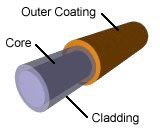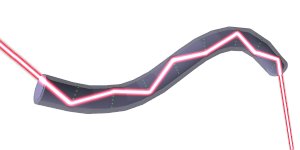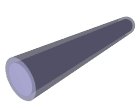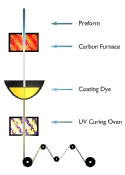Optical Fibres
An optical fibre is a fibre of glass no thicker than a human hair. They have an exterior cladding surrounding an inner core that is about one twentieth the diameter of a human hair.
The main components of an optical fibre are:
- Core - Glass centre of the fibre where the light travels.
- Cladding - Outter layer surronding the core that reflects the light back into the core.
- Outer Coating - Plastic cover that proctects the fibre from the enviroment.
Many of these optical fibres are put into bundles forming optical cables. These cables are then covered in a plastic jacket.
Cheaper optical fibres can also be made out of plastic. These fibres have are much larger than their glass counterparts and have a core of about 1mm in diameter. Visible light is transmitted through these fibres by LEDs (Light Emmiting Diodes). These are the types of optical fibres used in toys or christmas trees.
Optical fibres can be used to transmit data in either digital or analogue form using light. The best way to create the light is using lasers. The light is guided through the fibre by the core, this happens because of total internal reflection.
How They Work
The light travels through the fibres core, which has a hign index of refration, by continually reflecting from the outer layer of glass or cladding, which has a lower index of refraction, because the angle of the light is always greater than the critical angle. The light will always reflect from the cladding no matter how much the fibre is bent, even if it is bent into a complete circle!
The cladding does not absorb any of the light that it reflects letting the light travel large distances. However, due to impurities in the glass some of the light signal does degrade. The ammount of degradation that does occour depends on how pure the glass in the fibre is and the wavelenght of the light being transmitted.
Example:
Light with a wavelenth of 850nm will degrade 60-75% per kilometre, where light with a larger wavelenth of 1300 nm will only degrade 50-60 % per kilometre. There are some high quality fibres that have much less signal deteration, with less than 10% per kilometre for light with a wavelength of 1550 nm.
Advantages of Optical Fibres
- Cheaper - Many kilometres of optical fibre can be made much cheaper than copper cable
- Higer Bandwidth - Because of how thin they are many more optical fibres can be bundled into a cable than copper wires.
- Less degredation - Light signals travelling through an optical fibre takes longer to degrade than traditional copper cables.
- Less interference - Unlike copper cables optical fibres do not suffer from electrical interference. Light traveling through one fibre does not affect light traveling in another fibre. This results in higher speed because the same signal has only has to be sent once and clearer TV pictures and phone calls.
- Zero fire hazzard - Since there is no electricity travelling through the fibres there is no risk of fire
- Low power - Since the signals travelling through the fibre degrade less low power transmitters can be used instead of high voltage ones used in copper networks
How Optical Fibres are Made
Optical fibres are made of extremly pure silica glass. If you were to stack many sheets of ordinary window glass on top of one another, you would have a hard time seeing through them. However, if you were to do the same thing with the glass used in optical fibres, you would have no trouble. In fact, if you had an entire ocean made of the glass, you would be able to clearly see the ocean floor.
Optical fibres start life as a preform made by rotating a hollow glass tube on a lathe. The preform is made using a process called modified chemical vapor deposition (MCVD).
As the tube is rotated, a flame moves back and forth along the outside while a gas vapor made of oxygen bubbled through solutions of silicon chloride (SiCl4), germanium chloride (GeCl4) and other chemicals are conducted into the tube.
The heat causes the silicon and germanium to react with oxygen, forming silicon dioxide (SiO2) and germanium dioxide (GeO2). These two substances are then deposited inside the tube forming the core and the cladding that surrounds it. This process is automated and takes several hours to complete.
This tube is collapsed, forming a glass rod about a metre long. It is now basically an enlarged version of the final fibre. This one metre long rod has the potential to be made into about ten kilometres of optical fibre.
The final fibre is made by placing the preform vertically on the top of a draw tower. The lower end of the preform is lowered into a carbon furnace and heated to 1800°C. Gravity pulls down the molten glob on the end which is then pulled into a thin fibre of glass. The fibre is pulled at a rate of 10-20 m/s from the preform. This fibre is coated with a layer of plastic to protect it from mechanical and environmental forces and to give it extra strength. The newly formed optical fibre is finally wound onto a bobbin.




